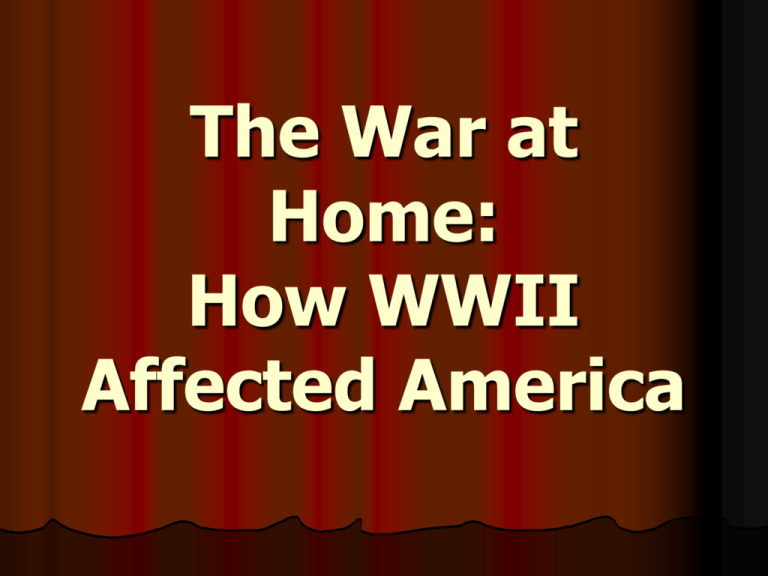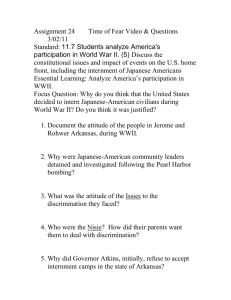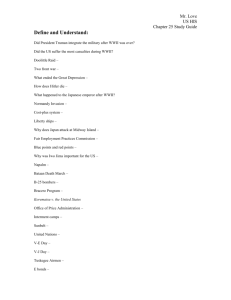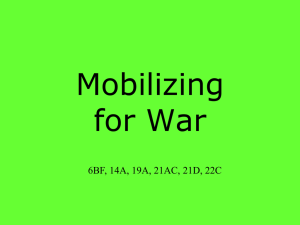The War at Home
advertisement

The War at Home: How WWII Affected America US Preparations for War Prior to entering WWII, FDR began increasing the size of the US military and ordered increased production of war materials like planes The government awarded factory owners with lucrative contracts to increase military production After Pearl Harbor, almost all US industry was converted to military use Selective Service and Training Act Passed in 1940, after the fall of France to Germany First peace-time draft in US history Required 12 months service if drafted (requirement dropped during war) All men ages 18 -36 had to register (expanded during WWII to ages 18 – 65) Over the 7 years the act was in effect, over 10 million were drafted War Production Board Created after US entered the war to regulate war-time industry by deciding priorities, setting production goals, and controlling distribution of raw materials and supplies Automobile Industry & War Auto factories were among first converted to war production, making jeeps, tanks, trucks, and other gear Henry Ford even began building bombers on his assembly lines By end of WWII, auto industry had produced 1/3 of all US military supplies used Liberty Ships Standardized cargo ships which could be produced quickly (could be built in just 42 days), cheaply, and in large numbers Ships seams were welded, rather than riveted, which made them both cheaper and harder to sink Over 2700 were built during the war, and only about 300 were sunk War Revenue War cost more than $300 billion – more money than the US government had spent in its entire existence War Bonds: sold over $150 billion in bonds (small private loans) Income taxes: withheld directly from people’s paychecks for the first time; tax rate raised Wartime Rationing Ration books: to purchase many goods (tires, gas, silk stockings, etc.), consumers had to have special coupons allowing them to buy Victory Gardens: Americans were encouraged to grow their own food where possible Scrap drives: rubber, tin, aluminum, steel, animal fats and grease were all collected for recycling Patriotism & Propaganda Posters: America was covered with propaganda posters promoting everything from recycling to enlistment Newsreels: movie theaters showed patriotic films, pro-US news clips to keep Americans motivated Women in the Military US Army accepted women for the first time (Women’s Army Corp), but in noncombat roles, to free up more men for combat service Over 275,000 women would serve in the WAC & WAVES (US Navy’s Women Accepted for Volunteer Emergency Service) Women in the Workforce As men entered military service, women stepped into traditionally male roles, such as working in factories Millions of women entered the US workforce and would show some reluctance to leave it after the war Rosie the Riveter Character based on a popular song about a woman who took a factory job to support her Marine boyfriend in the war Became a nationally recognized symbol for the important role of women workers “Double V” Campaign Due to a segregated military, some blacks did not support the war Others supported the idea of a “Double V” campaign – by fighting in the war, AfricanAmericans could win a double victory – victories over Hitler’s racism abroad and over racism at home Benjamin O. Davis 1877 – 1970 Joined Army during Spanish-American War, worked his way up from Private Highest ranking black officer in the US Army, was first black promoted to General Promoted by FDR to show support for ending discrimination in the armed forces Black Soldiers Although the military remained segregated until after the war (1948), all-black units served with distinction and began to win respect from the military leadership and from their fellow soldiers Tuskegee Airmen 99th Pursuit Squadron All-black unit trained as fighter pilots at the Tuskegee Institute in Alabama Once allowed to entire combat in the European Theater as bomberescorts, they proved their ability by not losing a single bomber on missions in which they were providing the protection Executive Order 8802 Due to discriminatory hiring practices in the US, Roosevelt issued an executive order in June 1941, banning racial discrimination in government hiring and in industries engaged as defense contractors Established the Fair Employment Practices Commission to enforce the order – the first federal civil rights agency since Reconstruction ended Native American Soldiers Thousands of Native Americans served, especially in the Marine Corps About 300 Navajo worked as “code talkers,” using their native language to transmit radio messages for the Marines, a code which was never broken by the Japanese! Bracero Program Due to labor shortages on farms in the Southwest US, the federal government arranged for Mexican workers to help with the harvest Over 200,000 Mexicans entered the US as part of the Bracero Program, and began a tradition of US reliance on Latino migrant farmers Zoot Suit Riots June 1943 Anti-Latino racism and a rise in juvenile crime, coupled with the “unpatriotic” fashion of “zoot suits” (large baggy suits which wasted material) which had been adopted by Mexican-American teens led to large-scale fights between soldiers and Latinos in Los Angeles Violence continued for days and led to a ban of Zoot Suits by the City of Los Angeles Hispanic-American Soldiers Despite episodes of racism, over 500,000 Hispanic Americans served in the Armed Forces during the war, primarily Mexicans and Puerto Ricans They served in every theater of the war and won 17 Medals of Honor Japanese Internment Fear of spies and saboteurs amongst the Japanese-American population on the West Coast prompted the US to “relocate” over 100,000 to internment camps Those interned lost homes, businesses, and jobs while detained from 1942 - 1945 Korematsu v. US Dec. 1944 Fred Korematsu sued the US government, claiming that his rights had been violated US Supreme Court ruled that the internment camps were legal because they were a matter of “military urgency” and were not based on race, but also ruled that loyal US citizens can not be held against their will, prompting the government to begin releasing those held at the camps Japanese-American Soldiers Again, despite racism, many JapaneseAmericans served in the US Armed Forces during the war, including the 442nd Regimental Combat Team, who became the most decorated unit of the entire war Population Shifts Over 15 million Americans moved during the war to fill open jobs Many moved into major industrial centers in the North, Midwest, and California, but more moved into the “Sunbelt” across the southern US Once again, millions of blacks left the South for northern and western cities, leading to racial tensions Wage and Price Controls To control inflation, the government acted to freeze prices on consumer goods and to freeze workers’ wages These frozen wages had the potential to create labor disputes Unions During the War Most unions pledged to not strike during the war but to instead seek mediation through the government’s War Labor Board Not all unions cooperated, and a 1943 strike by coal workers under John L. Lewis forced the government to intervene






